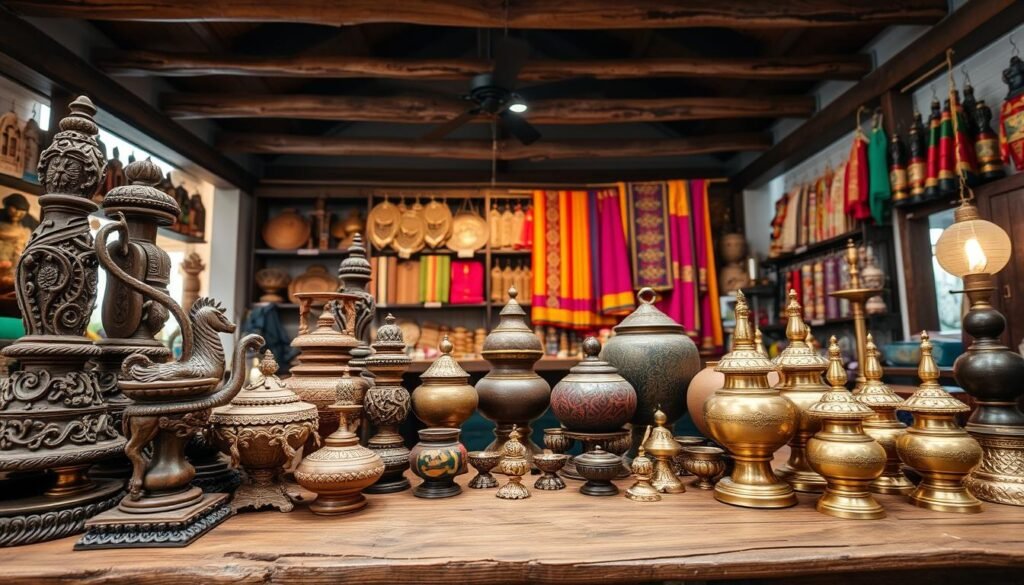
Have you ever dreamed of wandering through lush, fragrant gardens where the air is heavy with the scent of exotic spices? Imagine a place where cardamom, pepper, and cinnamon grow in abundance, their leaves glistening under the tropical sun. Welcome to Kerala, the spice capital of India, where you can turn this dream into reality! 🌿✨
Kerala’s spice plantations offer more than just a feast for the senses – they’re a journey through time, culture, and cuisine. As you step into these verdant estates, you’ll be transported to an era when spices were worth their weight in gold. But here’s the catch: with so many plantations to choose from and limited time on your trip, how do you ensure you’re getting the most authentic and enriching experience? Don’t worry, we’ve got you covered!
In this guide, we’ll take you on a virtual tour of Kerala’s finest spice plantations, revealing the best-kept secrets of the trade. From learning how to identify different spices to understanding their cultivation and uses, we’ll prepare you for an unforgettable adventure. So, let’s embark on this aromatic journey and discover why Kerala’s spice plantation tours are a must-add to your travel bucket list! 🌶️🌴
Discover Kerala’s Aromatic Treasures
Exploring the heart of India’s spice trade
Kerala, known as the “Spice Garden of India,” has been at the center of the global spice trade for centuries. This lush coastal state boasts ideal conditions for cultivating a wide variety of aromatic spices, making it a prime destination for spice enthusiasts and culinary adventurers alike. Kerala spice plantation tours offer visitors a unique opportunity to immerse themselves in the rich history and fragrant landscapes that have shaped the region’s identity.
Top spices grown in Kerala plantations
Kerala’s diverse climate and fertile soil support the cultivation of numerous spices. Here’s a list of the most prominent spices you’ll encounter on Kerala spice plantation tours:
- Black Pepper
- Cardamom
- Cinnamon
- Clove
- Nutmeg
- Ginger
- Turmeric
- Vanilla
| Spice | Flavor Profile | Common Uses |
|---|---|---|
| Black Pepper | Pungent, sharp | Seasoning, marinades |
| Cardamom | Sweet, floral | Desserts, chai tea |
| Cinnamon | Warm, sweet | Baking, curries |
| Clove | Strong, aromatic | Spice blends, medicinal |
The cultural significance of spices in Kerala
Spices are deeply woven into the fabric of Kerala’s culture, influencing everything from traditional cuisine to ancient Ayurvedic practices. The spice trade has played a crucial role in shaping Kerala’s history, attracting traders from around the world and contributing to the region’s unique multicultural heritage. Today, spices continue to be an integral part of Kerala’s economy and cultural identity, with Kerala spice plantation tours offering visitors a chance to experience this aromatic legacy firsthand.
Now that we’ve explored the aromatic treasures of Kerala, let’s delve into some of the best spice plantations you can visit during your trip.
Best Spice Plantations to Visit
Munnar’s cardamom hills
Nestled in the Western Ghats, Munnar’s cardamom hills offer a captivating experience for spice enthusiasts. The lush green landscapes are dotted with cardamom plants, creating a aromatic paradise. Visitors can explore vast plantations and learn about the cultivation process of this prized spice.
Thekkady’s pepper paradise
Thekkady is renowned for its exceptional black pepper, often called “black gold.” The region’s climate and soil conditions are perfect for growing high-quality peppercorns. Tourists can witness the entire pepper production cycle, from vine to table.
Wayanad’s ginger and turmeric fields
Wayanad’s spice plantations are a feast for the senses, with vibrant yellow turmeric and fragrant ginger fields stretching as far as the eye can see. These plantations offer insights into the cultivation and processing of these essential Indian spices.
Idukki’s clove and nutmeg estates
Idukki’s spice estates are famous for their aromatic cloves and nutmeg. Visitors can explore the plantations, learn about the unique harvesting techniques, and witness the drying process of these valuable spices.
| Plantation Location | Key Spices | Unique Features |
|---|---|---|
| Munnar | Cardamom | Scenic hill stations |
| Thekkady | Black Pepper | Wildlife sanctuary nearby |
| Wayanad | Ginger, Turmeric | Tribal culture experiences |
| Idukki | Cloves, Nutmeg | Stunning dam and reservoirs |
Kerala spice plantation tours offer a diverse range of experiences across these regions. Each destination provides a unique perspective on spice cultivation, allowing visitors to:
- Learn about sustainable farming practices
- Participate in spice harvesting (seasonal)
- Sample fresh, locally grown spices
- Purchase authentic spices directly from plantations
As we explore these aromatic destinations, let’s delve into what you can expect during a typical spice plantation tour in Kerala.
What to Expect on a Spice Plantation Tour
Guided walks through fragrant gardens
As you embark on your Kerala spice plantation tour, prepare to be enveloped by a symphony of aromas. Expert guides will lead you through lush, verdant gardens, where you’ll encounter a diverse array of spices growing in their natural habitat. You’ll witness:
- Tall pepper vines climbing sturdy trees
- Cardamom plants nestled in the shade
- Cinnamon trees with their distinctive bark
- Clove buds waiting to be harvested
These guided walks offer a unique opportunity to see, smell, and touch the spices that have made Kerala famous for centuries.
Hands-on spice harvesting experiences
Many plantations offer visitors the chance to participate in the harvesting process. This hands-on experience allows you to:
- Pick ripe peppercorns from the vine
- Collect fragrant cardamom pods
- Peel cinnamon bark from branches
- Pluck aromatic clove buds
| Spice | Harvesting Method | Best Season |
|---|---|---|
| Pepper | Hand-picking | December-February |
| Cardamom | Pod collection | August-October |
| Cinnamon | Bark peeling | Year-round |
| Clove | Bud plucking | October-January |
Learn traditional cultivation techniques
During your tour, you’ll gain insights into the time-honored methods of spice cultivation. Knowledgeable farmers will demonstrate:
- Sustainable farming practices
- Natural pest control methods
- Proper irrigation techniques
- Ideal growing conditions for each spice
These traditional techniques have been passed down through generations, ensuring the highest quality spices while preserving the environment.
Taste authentic Kerala cuisine featuring local spices
No spice plantation tour is complete without savoring the flavors of Kerala’s renowned cuisine. Many plantations offer:
- Cooking demonstrations using freshly harvested spices
- Tasting sessions of traditional Kerala dishes
- Opportunities to purchase spices directly from the source
This culinary experience allows you to fully appreciate the role of spices in Kerala’s rich gastronomic heritage. As we explore the flavors of Kerala, let’s now turn our attention to planning your spice plantation visit.
Planning Your Spice Plantation Visit
Best time to visit Kerala’s spice farms
The ideal time to explore Kerala’s spice plantations is during the post-monsoon season, from October to March. This period offers pleasant weather and lush greenery, enhancing your experience. Here’s a breakdown of the best months:
| Month | Advantages |
|---|---|
| October-November | Mild temperatures, reduced humidity |
| December-January | Cool climate, perfect for outdoor activities |
| February-March | Blooming spice plants, ideal for photography |
Tour duration and pricing
Spice plantation tours in Kerala typically last between 1-3 hours. Prices vary depending on the plantation and tour package:
- Basic tour (1-2 hours): ₹200-500 per person
- Extended tour (2-3 hours): ₹500-1000 per person
- Full-day experience: ₹1000-2000 per person
Many plantations offer group discounts and customized packages for longer stays.
What to wear and bring
For a comfortable spice plantation tour, consider the following:
- Lightweight, breathable clothing
- Comfortable walking shoes
- Sun hat and sunglasses
- Insect repellent
- Bottled water
- Camera for capturing memories
Accommodation options near plantations
To fully immerse yourself in the spice plantation experience, consider staying at:
- Plantation homestays
- Eco-friendly resorts
- Boutique hotels in nearby towns
These options often provide easy access to multiple plantations and offer authentic Kerala cuisine featuring local spices.
Now that you’re equipped with the essential information for planning your visit, let’s explore what lies beyond the spice tour experience in Kerala.
Beyond the Spice Tour
A. Combine with Kerala’s other attractions
Kerala offers a wealth of experiences beyond its famous spice plantations. To make the most of your visit, consider combining your spice tour with other iconic attractions. Here’s a list of must-see destinations to complement your aromatic adventure:
- Backwaters of Alleppey
- Beaches of Kovalam and Varkala
- Tea plantations of Munnar
- Wildlife sanctuaries like Periyar
- Historic Fort Kochi
| Attraction | Distance from Spice Plantations | Ideal Duration |
|---|---|---|
| Alleppey | 2-3 hours | 1-2 days |
| Munnar | 3-4 hours | 2-3 days |
| Fort Kochi | 1-2 hours | 1 day |
B. Shop for high-quality spices to take home
After experiencing the lush spice plantations, you’ll undoubtedly want to bring some of Kerala’s aromatic treasures home. Many plantations offer on-site shops where you can purchase freshly harvested spices. For a wider selection, visit local markets in nearby towns. Here are some tips for buying authentic Kerala spices:
- Look for whole spices rather than powdered forms
- Check for vibrant colors and strong aromas
- Buy from reputable sources or government-approved shops
- Consider purchasing spice blends like garam masala or curry powder
C. Learn to cook with fresh Kerala spices
To truly appreciate Kerala’s spices, why not learn how to use them in traditional dishes? Many resorts and homestays offer cooking classes where you can master the art of Kerala cuisine. These hands-on experiences typically include:
- Selecting fresh ingredients from local markets
- Learning about spice combinations and their health benefits
- Preparing popular dishes like Kerala fish curry or vegetable thoran
- Enjoying your culinary creations with fellow food enthusiasts
D. Support sustainable spice farming initiatives
As you explore Kerala’s spice plantations, consider supporting sustainable farming practices. Many small-scale farmers are adopting eco-friendly methods to preserve the region’s biodiversity and ensure the longevity of spice cultivation. Here are ways to contribute:
- Choose organic spice plantations for your tours
- Purchase products from fair-trade certified farms
- Participate in agri-tourism programs that benefit local communities
- Learn about and spread awareness of sustainable spice farming techniques
By engaging in these activities, you’ll not only enrich your Kerala spice plantation experience but also contribute to the preservation of this aromatic heritage for future generations.

Kerala’s spice plantation tours offer a unique and immersive experience for visitors to explore the aromatic treasures of this beautiful Indian state. From discovering the best plantations to understanding what to expect during your visit, these tours provide an opportunity to delve deep into the rich history and culture of Kerala’s spice trade.
As you plan your spice plantation visit, remember to consider the ideal time to go, book in advance, and prepare for the tropical climate. Beyond the spice tour itself, take time to explore the surrounding areas, indulge in local cuisine, and embrace the warm hospitality of Kerala. Whether you’re a culinary enthusiast, nature lover, or simply seeking a memorable adventure, a Kerala spice plantation tour promises to awaken your senses and leave you with lasting memories of this enchanting region.









